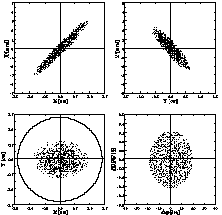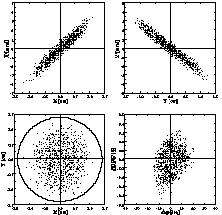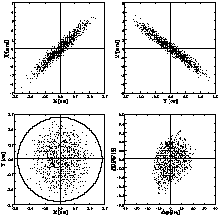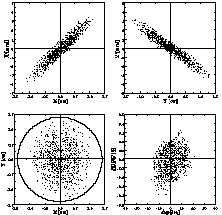Heavy ion linear accelerators are well suited as driver in heavy ion inertial fusion facilities. In present scenarios the acceleration of different ion species or the simultaneous acceleration of different isotopes in the same linac are discussed. Beam dynamics calculations have been performed to check the beam behaviour and the conditions for such a kind of operation in RFQ and DTL.
Heavy ion inertial confinement fusion is considered to be an attractive method to create a future powerful source of energy. Several studies are underway to design a driver facility for the generation of the required very intense heavy ion beams for pellet ignition.
One possible way is an rf-linac / storage-ring approach [1,2], where the beam is accelerated in a long main linac to the final energy and then injected into the rings for storage and compression. In all parts severe limitations exist due to space charge effects and emittance growth.
While the first driver proposals dealt with the acceleration of only one ion species, like Bi+, recently the use of different ion species or isotopes has been suggested to overcome especially space charge limits.
In the proposal for a charge symmetric driver [3], the simultaneous acceleration of the four main isotopes of Pt, both positively and negatively charged, is foreseen to increase the current limit in the final transport channel by space charge neutralisation. The idea of telescoping of ion bunches [4] propagates the non-Liouvillian time overlap of bunches of ions with different masses but same momentum, which allows the use of the same final focusing channel.
In the latter proposal the ion species changes in the accelerator from macropulse to macropulse, which may allow the switching of the linac parameters from pulse to pulse (already routine operation for the UNILAC of GSI at low currents [5]), while in the case of the space charge neutralised driver the ion species is changing from micropulse to micropulse, i.e. only simultaneous acceleration is possible.
In the main linac of the driver facility, heavy ion currents in the range of some hundreds of mA up to some A must be accelerated to meet the power requirements for pellet ignition. Limitations for the accumulation of such intense ion beams at low particle energies are the maximum current that can be extracted from a single ion source and the current transport capability of LEBT and RFQ. Therefore in all rf linac designs a funnelling scheme [6] is under consideration, in which the beams of 8 or 16 ion sources are bunched and pre-accelerated and then bent together in successive steps, where the rf frequency is doubled in each step.
In the MRTI - ITEP (Moscow) proposal [7] the linac starts with 4 ion sources producing positively charged Pt ions of the isotope masses A = 192, 194, 196 and 198 and another 4 sources for negatively charged Pt ions. The beams with identical current and emittances are bunched and accelerated by 4 ¥ 8 Radio Frequency Quadrupoles (RFQs) and then merged into one main linac, consisting of Wideroe and Alvarez type Drift Tube Linacs (DTLs). It is proposed to design all RFQs for an average mass number 195; in this case, transmission and output emittances for the 4 isotopes accelerated with the same electrode voltage differ only slightly at low beam currents [8]. For a design current near the theoretical current limit, this is still investigated.
As another example, the beam behaviour for the 4 positively charged
Pt isotopes has been examined for the first part of an Alvarez
DTL, following the MRTI proposal. Again the linac parameters were
chosen for the intermediate mass 195 (Table 1); the generation
of the linac for particle dynamics calculations has been done
with the code packages CLAS, GENLIN and ADAPT.
| Energy | ||
| Cell length (bl) | ||
| Gap length (bl/5) | ||
| Frequency | ||
| E-field gradient | ||
| Bore radius | ||
| Synchronous phase | ||
| Total length | ||
The tank radius and the drift tube outer diameters were optimized with CLAS in order to get the right frequency for both the first and last cell of the linac. Then results were interpolated with GENLIN in order to get the features of all the intermediate cells. The quadrupole lengths were set to 92% of the tube lengths and their gradients were computed with ADAPT for the first 250 cells of the linac (86.9 m), corresponding to an energy range from 600.0 to 798.3 MeV. Each focusing period is formed by 5 lenses of the same sign followed by 5 lenses of the opposite one (i.e. FFFFFDDDDD), in order to limit the maximum gradient, which is now between 34.2 and 28.5 T/m, smoothly decreasing from a quadrupole to the next one, though it was found that using the same value for all the 5 quadrupoles of the same sign within a period gives nearly identical output results.
For the beam input, the following parameters were used:
| Horizontal beam size | |
| Vertical beam size | |
| Horizontal emittance | |
| Vertical emittance | |
| Bunch length | |
| Momentum spread (dp/p) | |
| Current |
The quoted emittances are full values, not normalized; rms normalized emittances may be obtained dividing by 5 and multiplying by bg. The Twiss parameters bx,y are obtained from the emittances and the beam size values, assuming ax,y = 0. Similarly, the longitudinal emittance is the product of bunch length and momentum spread, while bz is obtained from the emittance and the bunch length values, assuming az = 0. Calculations were started at low current, that was then raised stepwise to pulse currents of 30-40 mA (total current 400-500 mA), which are presently available from heavy ion sources.
The acceptance of such a linac was computed running MAPRO for the first 250 cells only (due to limited storage and computing time), using the above input values. It was then possible to adjust ax,y in order to match the acceptances and maximize the number of transmitted particles.
With the input Twiss parameters above, an input distribution for 2000 particles was generated, using a 4-dim waterbag random distribution in both transverse planes and, independently, a 2-dim waterbag distribution in the longitudinal one (Fig. 1). Then particle dynamics calculations were performed with MAPRO on the linac structure generated by CLAS, GENLIN and ADAPT, for the intermediate atomic mass A = 195 and for the 4 isotopes (A = 192, 194, 196 and 198) with positive charge only, where matching of the beam and reduction of emittance growth turned out to be rather time consuming.
Preliminary results show that it is possible to accelerate different isotopes in the considered part of the linac: for all masses, the transmission is higher than 97% and the emittance growth is similar, as shown in Table 3 (full emittance) and Table 4 (95% emittance).
The output emittances are given in Figures 2 to 4.




The acceleration of different ions in the same linac
with a fixed parameter setting is proposed in new heavy ion fusion
driver design. For a perfect neutralisation of the beam current
in the final focus transport line, beams of identical current
and bunch dimensions must be delivered from the driver linac.
In a first attempt, beam dynamics calculations indicated that
variation of beam current and emittances within a few percentages
can be achieved for the simultaneous acceleration of different
masses. More work will be done for lower emittance growth and
higher beam currents.